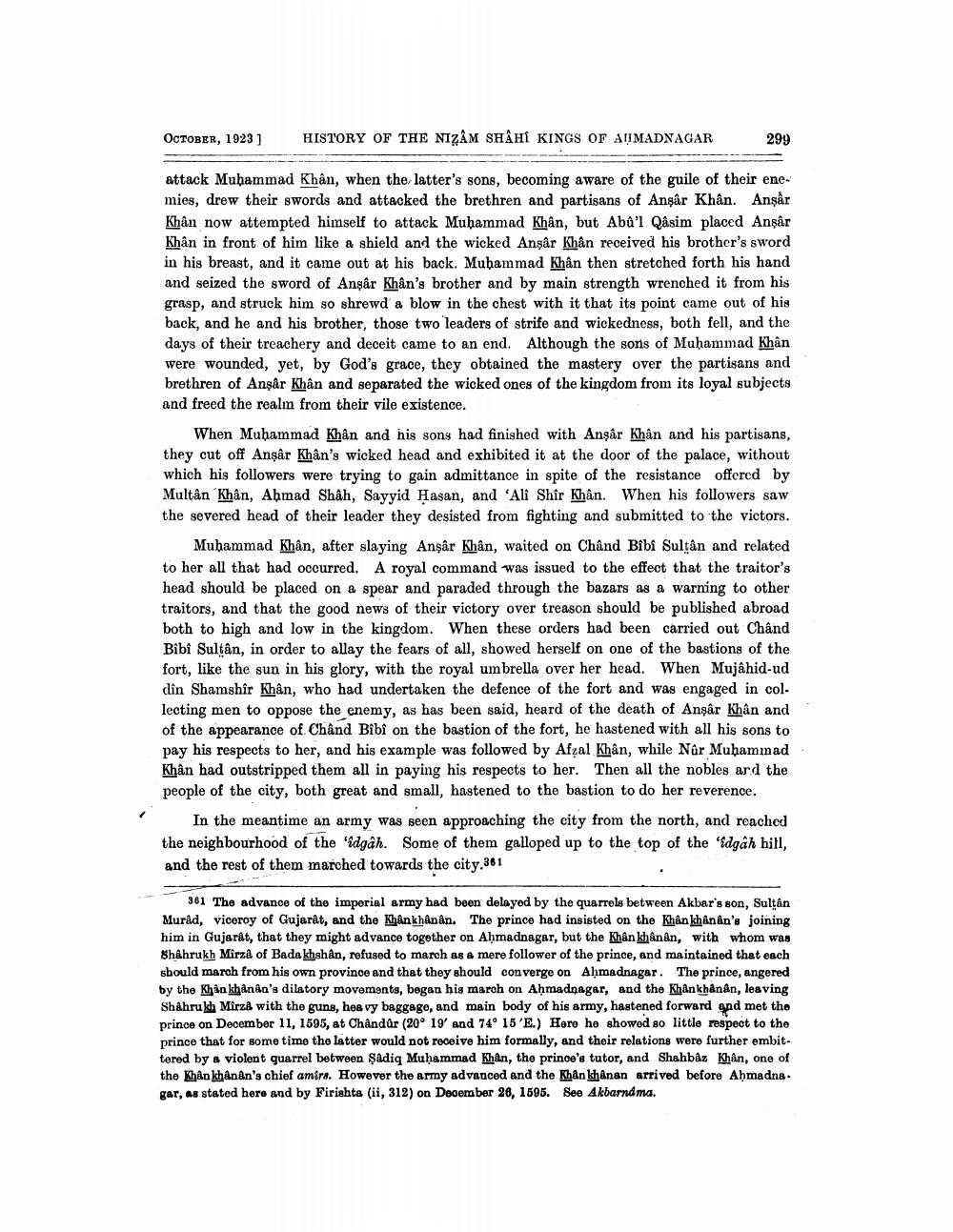________________
OCTOBER, 1923]
HISTORY OF THE NIZAM SHAH KINGS OF ANIMADNAGAR
299
attack Muhammad Khân, when the latter's sons, becoming aware of the guile of their enemies, drew their swords and attacked the brethren and partisans of Anşar Khân. Ansår Khân now attempted himself to attack Muhammad Khân, but Abû'l Qasim placed Anşâr Khân in front of him like a shield and the wicked Ansar Khân received his brother's sword in his breast, and it came out at his back. Muhammad Khân then stretched forth his hand and seized the sword of Anşâr Khân's brother and by main strength wrenched it from his grasp, and struck him so shrewd a blow in the chest with it that its point came out of his back, and he and his brother, those two leaders of strife and wickedness, both fell, and the days of their treachery and deceit came to an end. Although the sons of Muhammad Khân were wounded, yet, by God's grace, they obtained the mastery over the partisans and brethren of Ansår Khan and separated the wicked ones of the kingdom from its loyal subjects and freed the realm from their vile existence.
When Muhammad Khan and his sons had finished with Angâr Khan and his partisans, they cut off Ansar Khân's wicked head and exhibited it at the door of the palace, without which his followers were trying to gain admittance in spite of the resistance offered by Multân Khân, Ahmad Shah, Sayyid Hasan, and 'Ali Shîr Khân. When his followers saw the severed head of their leader they desisted from fighting and submitted to the victors.
Muhammad Khân, after slaying Anşar Khân, waited on Chånd Bibi Sultân and related to her all that had occurred. A royal command was issued to the effect that the traitor's head should be placed on a spear and paraded through the bazars as a warning to other traitors, and that the good news of their victory over treason should be published abroad both to high and low in the kingdom. When these orders had been carried out Chând Bibi Sultân, in order to allay the fears of all, showed herself on one of the bastions of the fort, like the sun in his glory, with the royal umbrella over her head. When Mujahid-ud dîn Shamshîr Khân, who had undertaken the defence of the fort and was engaged in col. lecting men to oppose the enemy, as has been said, heard of the death of Anşar Khân and of the appearance of Chånd Bibi on the bastion of the fort, he hastened with all his sons to pay his respects to her, and his example was followed by Afzal Khân, while Nûr Muhammad Khân had outstripped them all in paying his respects to her. Then all the nobles ard the people of the city, both great and small, hastened to the bastion to do her reverence.
In the meantime an army was seen approaching the city from the north, and reached the neighbourhood of the 'idgah. Some of them galloped up to the top of the "Edgah hill, and the rest of them marched towards the city 361
361 The advance of the imperial army had been delayed by the quarrels between Akbar's son, Sultan Murad, viceroy of Gujarat, and the Khân khânân. The prince had insisted on the Khân khânân's joining him in Gujarat, that they might advance together on Ahmadnagar, but the Khân khånân, with whom was Shahrukh Mirzê of Badakhshân, refused to march as a mere follower of the prince, and maintained that each should march from his own province and that they should converge on Ahmadnagar. The prince, angered by the Khin khanan's dilatory movements, began his march on Ahmadnagar, and the Khân khânân, leaving Shahrukh Mirzê with the guns, heavy baggage, and main body of his army, hastened forward and met the prince on December 11, 1595, at Chân dûr (20° 19' and 74° 15'E.) Here he showed so little respect to the prince that for some time the latter would not receive him formally, and their relations were further embittered by a violent guarrel between Sadiq Muḥammad Khân, the prince's tutor, and Shahbaz Khân, one of the Khân khânân's chief amirs. However the army advanced and the Khân khanan arrived before Ahmadna. gar, as stated here and by Firishta (ii, 312) on December 26, 1595. See Akbarndma.




